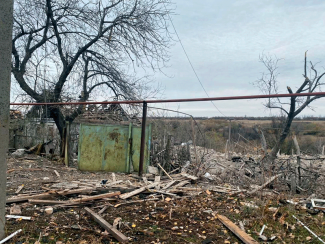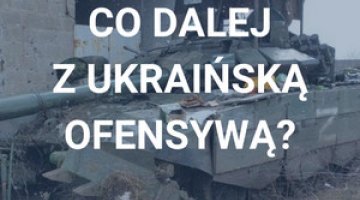Progressive flanking of Kurakhove. Day 985 of the war


Russian forces made further advances in the western part of the Donetsk Oblast, extending their flanking of the Ukrainian grouping in the Kurakhove area. The villages bordering it from the north-east came at least partially under their control. The Russian aggressor units attacking from the south advanced a further 3–6 km into the Ukrainian grouping. They also renewed their assault in the western direction, penetrating the defenders’ positions up to 5 km deep on a 10 km wide front. The Russians also resumed their assault west of Selydove, towards the main road now linking Pokrovsk and Kurakhove. There, too, they penetrated about 5 km and entered the village of Novooleksiivka.
Ukrainians have stepped up efforts to defend Pokrovsk, which will be turned into a fortress. The local military administration has announced that entry and exit to the city will be blocked. It has also repeated its appeal to residents to evacuate (11,900 remain as of 30 October). The Russians are less than 7 km from the city. Apart from constant shelling and airstrikes, there are no other signs of preparations for its capture.
In the other directions, Russia’s advance slowed down, and the field advances achieved were insignificant. In the Zherebets River area, there has been a bilateral realignment of the front line, and in the vicinity of Lyptsi, north of Kharkiv, the Ukrainians have regained some of the positions they previously held. Russia is now concentrating on liquidating the enemy’s grouping in the western part of the Donetsk Oblast, and treating the other directions as auxiliary. Activation on them occurs when the local Ukrainian grouping is weakened – most often as a consequence of the withdrawal and redeployment of part of their forces to the Pokrovsk area or the Kursk Oblast. However, the situation north of Kharkiv indicates that, should conditions allow, the Ukrainians are not giving up on regaining at least some of the lost territories which are not currently considered to be important.
According to the Ukrainian government, North Korean soldiers are fighting on the side of Russia in the Kursk Oblast, and some media outlets report that around 40 have been killed in clashes with Ukrainians. The Pentagon claims that Russia has deployed 12,000 North Korean military personnel to the Kursk Oblast, but has not yet decided how to use them. South Korean intelligence, on the other hand, reports that 10,000 North Korean troops have been deployed in the Russian Federation, “a significant number of whom have moved to the frontline areas, including Kursk”, but that they are not taking part in the fighting.
On 2 November, Ukraine’s military intelligence (HUR) reported that in the last week of October, the enemy deployed more than 7,000 North Korean army soldiers near Ukraine’s borders. They are equipped with arms provided by the Russian army (AK-12 assault rifles, 60mm mortars, RPK/PKM machine guns, SWD/SWCz sniper rifles and RPG-7 grenade launchers). The day before, President Volodymyr Zelensky stated that Ukrainian forces could have made a pre-emptive strike against camps used by North Korean troops, but that they do not have long-range weaponry.

On 30 October, Russian missiles struck the railway bridge over the Dniester Liman in the village of Zatoka. There is no information in the Ukrainian media about the impact of the attack; Ukraine has only announced the shooting down of two of the ten missiles used by Russia. The bridge carries the main supply route from Romania and is also the primary route for transporting goods to Ukrainian Danube ports. The structure was previously attacked in April 2022 and February 2023, causing it to be periodically taken out of service. In previous strikes, however, the Russians used far fewer missiles.
Russian attacks on the rear of enemy forces were concentrated mainly in the Kharkiv and Dnipro municipalities. Kharkiv was hit mainly by guided aerial bombs (30 and 31 October and 3 and 5 November), and in the only confirmed rocket attack (1 November) the headquarters of the local Interior Ministry was hit. On four occasions (30 October and 1, 2 and 4 November), the Russians attacked the Dnipro River and its surroundings (including railway infrastructure). Their targets also included infrastructure in Zaporizhzhia (5 November), Odesa and its surroundings (29 and 31 October) and the Khmelnytskyi (2 November), Cherkasy (31 October and 2 November) and Sumy (29 October and 3 November) oblasts, with the number of reports of energy facilities being hit decreasing (attacks on businesses were most often reported).
The significant increase in the number of drones used by the Russia observed since mid-October (see Appendix) continues to be felt by Kyiv. Damage in the capital (officially due to falling shrapnel) was reported on 2 and 3 November. According to Ukrainian data, between the evening of 29 October and the morning of 5 November, Russia used 39 missiles (Ukraine declared six destroyed) and 479 Shahed/Geran drones (284 drones are thought to have been destroyed and 167 were considered locally lost, which Kyiv said could be due to the impact of electronic warfare systems).

On 1 November, Ukrainian drones attacked a fuel base in Stavropol Krai and a fuel and energy complex (TEK) in Bashkortostan. A brief fire occurred on the site of the former. One day earlier, the target of the strike was the TEK enterprise in Ufa, where again no major damage was reported.

Russian intelligence continues to recruit young Ukrainian citizens and commission them for sabotage activities. On 30 October, three outposts of the postal operator Ukrposhta were set on fire in Kyiv. The perpetrator was apprehended – he was a high school student who, after completing his task, sent his ‘handler’ photographic documentation as a basis for payment of a fee. The 16-year-old faces up to seven years in prison for his crime.
On 2 November, Russian Foreign Ministry spokeswoman Maria Zakharova accused the Ukrainian side of sabotaging the exchange of hundreds of prisoners of war, while creating “the appearance of an international effort to free them”. According to her, Moscow offered to hand over 935 Ukrainian prisoners of war, of which Kyiv accepted only 279. She also suggested that the Ukrainian government was preventing the return of those who, for example, voluntarily surrendered to Russian. At the same time, there are reports in the Russian media that many Ukrainian prisoners of war are refusing to return, praising their conditions of stay in the Russian Federation.
Zakharova’s statement is an example of disinformation aimed at the Ukrainian public. Pointing to Kyiv’s alleged procrastination is intended to lower confidence in those in power, who are reportedly dividing POWs into ‘good’ and ‘bad’ ones. On 3 November, human rights ombudsman Dmytro Lubinets stressed that Ukraine is always ready to exchange prisoners of war in accordance with international law.

The first of the Canadian-funded NASAMS air defence systems is on its way to Ukraine. This was announced by President Zelensky after a conversation with Prime Minister Justin Trudeau on 4 November. Ottawa declared its intention to purchase NASAMS systems for Kyiv at a total cost of $300 million in January 2023.
On 1 November, the US Department of Defense released details of the 69th military aid package, worth $425 million. As part of the Presidential Drawdown Authority (PDA), the following will be transferred from the stockpiles of the local army. Stryker wheeled armoured personnel carriers (at least 211), NASAMS air defence system missiles, Stinger man-portable surface-to-air guided missiles, air-to-ground guided missiles (type not disclosed), HIMARS launcher ammunition, 155 mm and 105 mm calibre artillery shells, Javelin and TOW anti-tank guided missiles, AT-4 anti-tank grenade launchers, and drone combat equipment and ammunition (c-UAS).
On 30 October, Norwegian Defence Minister Bjørn Arild Gram announced the allocation of more than €108 million for the purchase of equipment and armaments for F-16 fighter jets being delivered to Ukraine, with the first previously Norwegian-owned aircraft of this type expected to arrive there before the end of the year. The Norwegian government’s website reports that €118 million have been earmarked to strengthen Ukraine’s air defence and support the transfer of the Patriot system from Romania to Kyiv. These reports detail the new €350 million military support package announced by Oslo on 28 October (Norway intends to spend a total of €500 million on civilian and military purposes). According to the Ukrainian defence ministry, more NASAMS air defence systems are to be funded from it.

Problems with the implementation of mobilisation plans have caused courts to waive the prosecution of men who have arbitrarily walked away from a military unit for the first time. In October, courts in the Lviv, Ivano-Frankivsk, Volyn, Zakarpattia and Ternopil oblasts issued around 100 decisions not to punish undisciplined soldiers, provided they voluntarily returned to their home units. Leaving a military unit or place of duty without a legitimate reason in a combat situation is punishable by up to ten years’ imprisonment.
On 5 November, the recruitment centre at the General Consulate of Ukraine in Lublin, which deals with recruitment for the Ukrainian Legion, announced that since the beginning of October, more than 500 applications for military service had been received (90% from men, 10% from women), mostly from people residing in Poland and the Czech Republic. Half of the applications were submitted by people under the age of 25. Young people declare their willingness to join assault troops or to be drone operators, while older people declare their willingness to join logistics units.

On 3 November, the Russian interior ministry revealed that 3,344 foreigners who took part in the aggression against Ukraine had received Russian passports since the beginning of the year. According to a decree signed by Vladimir Putin in January this year, foreigners can obtain the document without passing tests on their knowledge of the Russian language, Russian history and the basics of Russian legislation, and without the need for a residence permit.
Appendix. Monthly number of Shahed drone attacks in Ukraine

Source: own compilation based on information from the General Staff of the Armed Forces of Ukraine, the Air Force Command of the Armed Forces of Ukraine and regional military administrations.





